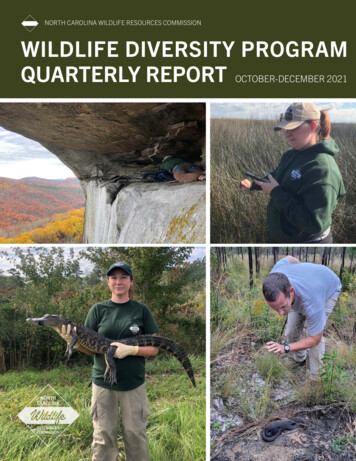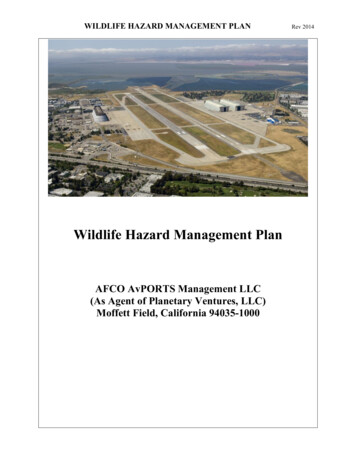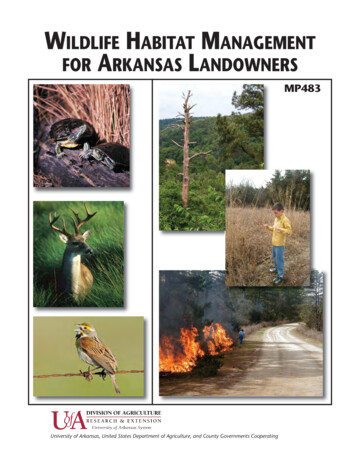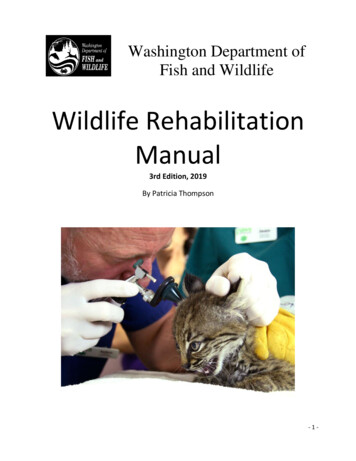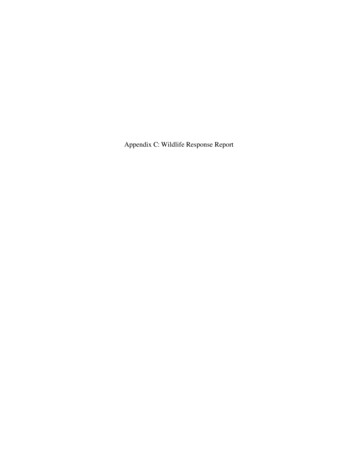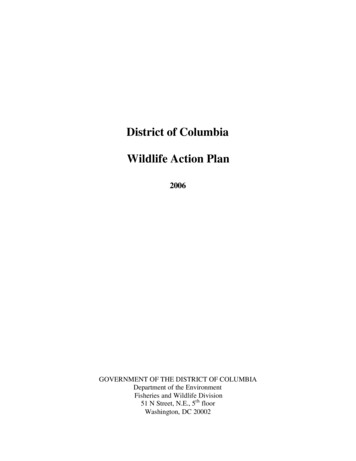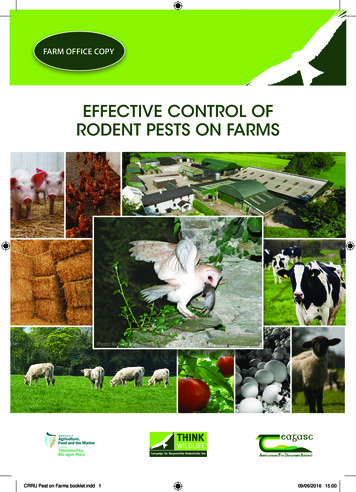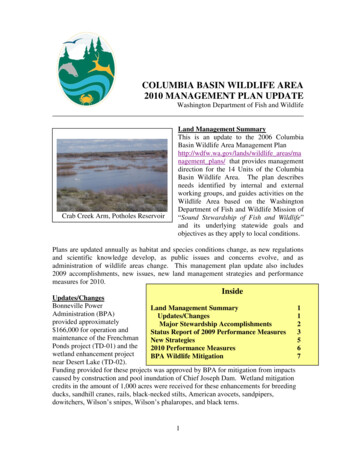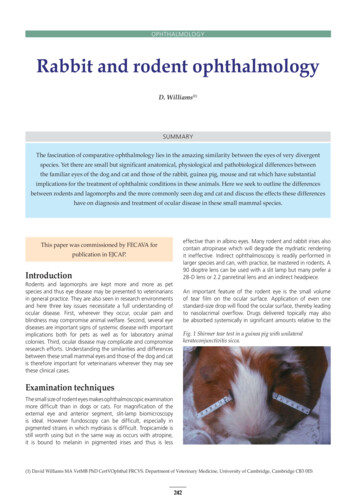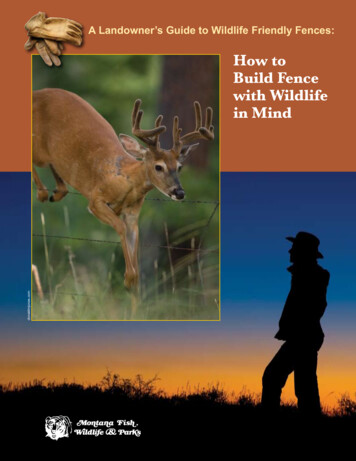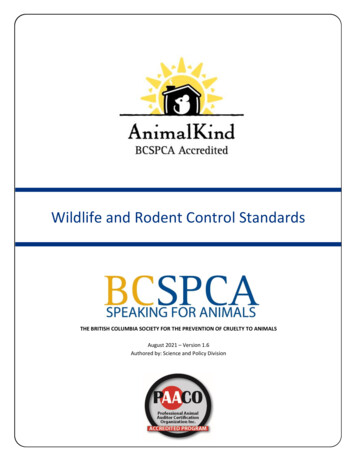
Transcription
Wildlife and Rodent Control StandardsTHE BRITISH COLUMBIA SOCIETY FOR THE PREVENTION OF CRUELTY TO ANIMALSAugust 2021 – Version 1.6Authored by: Science and Policy Division
Standards for Wildlife and Rodent ControlContentsPreface .3Introduction .3Purpose and Scope of the AnimalKind Accreditation Program and Standards . 3Background . 4Acknowledgements . 4AnimalKind Wildlife and Rodent Control Standards .5Standard 1: Business models align with a commitment to protect wild animal welfare . 5Standard 2: Ethical and legal business practices are followed . 5Standard 3: Prohibited devices, trap types, poisons or killing methods are not used . 6Standard 4: Human-wildlife conflicts are clearly diagnosed prior to the start of a control action . 8Standard 5: Customers are proactively educated about wildlife and rodent control options. 8Standard 6: Environments are modified to remove the reason for conflict and/or encourage animals todepart voluntarily . 8Standard 7: Removal methods that protect animal welfare are used to evict animals from structures andlocations of conflict. 9Standard 8: Cage-trapping and manual capture methods are rarely used . 11Standard 9: Release and relocation procedures protect animal welfare . 12Standard 10: Lethal methods are only used when an animal’s continued presence is an ongoing threat tohuman health and safety . 13Standard 11: Methods causing the least possible pain and distress are used when lethal control is justified. 14Standard 12: Lethal ‘kill-with-capture’ rodent control methods causing the least possible pain and distressare used . 15Standard 13: Rodenticides are only used when the continued presence of mice or rats is an ongoing threatto human health and safety. 17Standard 14: The welfare of working animals used for wildlife and rodent control is protected . 18Standard 15: Acts of cruelty and neglect are not tolerated . 20References .21Appendix 1 – Definitions .25Appendix 2 – Standard Operating Procedure Required Topics .28Appendix 3 – Prohibited Poisons and Rodenticides .29Appendix 4 – Brand Names of Permitted Rodenticides .30Appendix 5 – Critical Criteria for Animal Welfare .31Copyright BC SPCA 2021 Version 1.6Page 2 of 31
Standards for Wildlife and Rodent ControlPrefaceThe British Columbia Society for the Prevention of Cruelty to Animals (BC SPCA) developed the AnimalKindAccreditation Program and the AnimalKind Wildlife and Rodent Control Standards with funding from the PeterWall Institute for Advanced Studies and the Vancouver Foundation. The AnimalKind Wildlife and Rodent ControlStandards are based on widely accepted ethical principles and animal welfare science.The BC SPCA is one of the largest animal welfare organizations of its kind in North America. Established in 1895under the provincial Prevention of Cruelty to Animals Act (PCA Act), the Society’s mandate is to protect andenhance the quality of life for domestic, farm and wild animals in British Columbia. As a registered charity, the BCSPCA operates community animal shelters, education and adoption facilities, veterinary and spay/neuter clinics, awildlife rehabilitation centre, a provincial call centre, and an administration office. In addition to province-wideprograms for advocacy, government relations, humane education, and scientific research, Special ProvincialConstables enforce the PCA Act and Criminal Code of Canada to fulfill the Society’s law enforcement functions.IntroductionPurpose and Scope of the AnimalKind Accreditation Program and StandardsThe AnimalKind Accreditation Program (the “Program”) aims to decrease wild animal suffering by promotingWildlife Control Service Providers (“WCSPs”) who prioritize the use of non-lethal, removal-and-exclusion methodsto resolve human-wildlife conflicts. In the limited cases where use of live capture or lethal control methods arejustified, the Program supports only those methods that are legal and cause fewer harms to animal welfare. TheProgram contributes to public education by raising awareness of the animal welfare outcomes of traditionalwildlife and rodent control methods.Wildlife generally refers to animal species that have not been domesticated, and includes species that areintroduced or native, and wild-born or captive-bred. The AnimalKind Wildlife and Rodent Control Standards (the“Standards”) apply to free-living, vertebrate animals designated as wildlife by the BC Wildlife Act Designation andExemption Regulation and any introduced wildlife species. Free-living refers to animals that are currently notliving in captivity and may be independent of humans, therefore the Standards do not apply to wildlifepermanently in captivity (for example, those held in zoos). Introduced species, which may or may not crossreferenced in the BC Wildlife Act, include those that are alien, exotic, foreign, non-indigenous, or a non-nativespecies living outside of its natural range as a result of human activity.Feral cats and feral horses are not designated as wildlife by the BC Wildlife Act and are domestic species so theseStandards do not apply to them; however, feral rabbits and feral pigs are designated wildlife by the BC Wildlife Actand the Standards would apply. The Standards also apply to the introduced species of commensal rodents,Norway rat (Rattus norvegicus), roof rat (Rattus rattus) and the house mouse (Mus musculus). Although negativelyregarded as a significant “pests” given their associations with zoonotic diseases and property damage, thecommensal rodents have the same capacity to experience pain and distress as other vertebrates and it is on thisbasis that animal welfare considerations in the Standards have been extended towards them.The Standards were developed primarily for control of wildlife and rodents that come into conflict with humans inurban and residential settings (i.e. structural pest control). However, they could be used to guide control decisionsand actions in other types of locations.Copyright BC SPCA 2021 Version 1.6Page 3 of 31
Standards for Wildlife and Rodent ControlAccreditation is intended for organizations or businesses that manage and/or provide wildlife or rodent controlservices, either for external customers or internally as part of maintenance of the organizations’ or businesses’own facilities in British Columbia (BC). Accreditation may also be considered for companies that perform wildlifeand rodent control on an ad hoc basis (e.g. as part of lawn care or sign maintenance), for project-basedconservation programs, or for companies that use detector dogs for insect pest control and wish to have thirdparty animal welfare accreditation for their use of working dogs. The Program does not currently accredit entitiesoutside of BC.To be eligible for accreditation, a WCSP must adhere to the Standards, which outline acceptable and prohibitedactions, and the terms and conditions of the Program, outlined in the AnimalKind Accreditation ProgramOperations Manual (the “Operations Manual”). In addition, accredited WCSPs are expected to adhere to federal,provincial acts and regulations and municipal bylaws related to wildlife, pest management, animal cruelty and thelaws of Canada. When wildlife-proofing structures, WCSPs are also expected to install materials in accordancewith local building codes. The accreditation process is initiated when a WCSP submits an application to theProgram and is followed by participation in an audit process to establish that the WCSP meets the Standards.Accreditation must be renewed yearly and may involve an annual re-accreditation audit. The Program recoverssome operating costs through fees paid by WCSPs.BackgroundDevelopment of the Standards was informed by: applicable laws of BC and Canada; science-based animal welfareconcerns identified in the BC SPCA Humane Wildlife Control Evaluations [1]; and the ethical guidance of theInternational Consensus Principles of Ethical Wildlife Control [2] developed by expert consensus at a workshopheld at the University of British Columbia [3]. Ethical wildlife control is defined as the acceptability of a wildlifecontrol action based on a comprehensive analysis that includes the control action’s necessity, benefits, feasibility,costs to people and animals, alternatives, and effects on animal welfare in terms of the humaneness of thephysical methods employed.In particular, the following questions about wildlife control (derived from the International Consensus Principles)guided development of the Standards:1. Can the problem be mitigated by changing human behaviour?2. Are the harms serious enough to warrant wildlife control?3. Is the desired outcome clear and achievable, and will it be monitored?4. Does the proposed method carry the least animal welfare cost to the fewest animals?5. Have community values been considered alongside scientific, technical and practical information?6. Is the control action part of a systematic, long-term management program?7. Are the decisions warranted by the specifics of the situation rather than negative categorization of the animals?AcknowledgementsThe BC SPCA gratefully acknowledges Dr. David Fraser and the University of British Columbia Animal WelfareProgram for their leadership in applying animal welfare to free-living animals and their advice during thedevelopment of the Program. The BC SPCA also thanks the following individuals and groups for sharing theirexpertise: Alyssa Bell Stoneman, Dr. Cassandra Tucker, John Griffin, Dr. Dan Weary, Humane Society of the UnitedStates, PAACO review panel, and numerous wildlife and rodent control industry professionals. We also thank thePeter Wall Institute for Advanced Studies and the Vancouver Foundation, for funding and making possibledevelopment of the AnimalKind Accreditation Program and Wildlife and Rodent Control Standards.Copyright BC SPCA 2021 Version 1.6Page 4 of 31
Standards for Wildlife and Rodent ControlAnimalKind Wildlife and Rodent Control StandardsStandard 1: Business models align with a commitment to protect wild animal welfare1.1. WCSPs must have a written wild animal welfare policy to communicate expectations for techniciansregarding wild animal welfare (refer to Appendix 2 for required elements of policy).1.2. Technicians must demonstrate awareness of the wild animal welfare policy.1.3. Technician training must:a) use Standard Operating Procedures (SOPs) (refer to Appendix 2 for required SOP topics); andb) be documented with written records retained for at least 12 months.1.4. The WCSP must identify a professional wildlife rehabilitator operating in their provincial region or one ableto take animals from their region OR a local veterinarian in good standing with the College of BCVeterinarians who agrees to provide emergency euthanasia services for wildlife.1.5. Technicians or the WCSP must not have been convicted of an offence involving wildlife or animal cruelty,and/or have not had animals seized pursuant to any other provincial legislation.1.6. Concurrent operation of another non-accredited wildlife or rodent control business alongside the wildlife orrodent control business intended for accreditation is prohibited (including branches and franchises, butexcluding the parent company of a subsidiary company).1.7. Partnerships, subcontracting or referrals to another non-accredited wildlife or rodent control business isprohibited.1.8. The sale, barter, trade, permanent display, or use of any wildlife or wildlife parts (i.e. pelts) for any purposethat does not conform to the Standards is prohibited to ensure there is no financial incentive for the WCSPto capture wildlife or use lethal control.1.9. To prevent transmission of disease, equipment that comes into contact with animals or animal blood orfeces must be cleaned prior to reuse.Standard 2: Ethical and legal business practices are followed2.1. A valid business license must be held where required by municipal and/or regional bylaws.2.2. Liability insurance must be held.2.3. The WCSP must operate in compliance with WorkSafe BC regulations.2.4. Technicians using rodenticides must hold valid pesticide applicator licenses in compliance with the BCIntegrated Pest Management Act and Regulations.2.5. Technicians using ladders or boom lifts must be trained on safety for working at heights.2.6. Technicians using gases to kill wildlife must be trained on the safe and effective use of gas chambers.2.7. Technicians using firearms to kill wildlife must be:a) trained on the safe and effective use of firearms (e.g. calibre, body placement, accuracy); andb) hold valid firearms licenses in compliance with the laws of BC.Copyright BC SPCA 2021 Version 1.6Page 5 of 31
Standards for Wildlife and Rodent Control2.8. Technicians must be trained on how to prevent injuries from animals (bites, scratches) and how and whento use personal protective equipment.Standard 3: Prohibited devices, trap types, poisons or killing methods are not used3.1. Only wildlife and rodent control devices, trap types, poisons and primary killing methods that conform tothe Standards may be used.3.2. Use or sale of the following devices, trap types, poisons and use of the primary killing methods is prohibited:Devices, trap types and poisons limb-restraint/leg-hold/body gripping (e.g. Conibear) traps or snares including foot-encapsulating traps(e.g. EGG) and neck snares electrocution traps rodent glue traps poisons other than specific rodenticides allowed by provincial exemptions and named in the Standards avian adhesive gel repellents (optical & tactile) predator odour repellent derived from captive wild animalsPrimary killing methods air embolism injection falconry for lethal control of birds or small mammals freezing chloral hydrate hypothermia chloroform maceration decapitation of conscious animal smothering/suffocation drowning thoracic compression electrocution of conscious animal vehicle exhaust to deliver carbon monoxide exsanguination of conscious animalThe above devices, trap types, poisons and primary killing methods are prohibited for one or more of thefollowing reasons: the method is illegal; it may cause excessive pain, distress or physical injury to a consciousanimal; it may result in an extended length of time to irreversible unconsciousness (TIU) to the target animal; itmay result in an extended length of time until the death of a target animal; or evidence examining humaneness ofthe device, trap type, poison or killing method is unavailable.AnimalKind Standards were developed from an animal welfare perspective and aim to prioritize control methodsthat cause fewer harms to animals, where possible. The assessments of control methods are informed by animaluse and killing standards, guidelines and policies produced by relevant North American regulatory organizationsand veterinary associations. However, AnimalKind assessments occasionally differ from the assessments of otherexpert organizations. These differences often arise from distinctions made between appropriate killing methodsfor domestic animals and wildlife maintained in captivity versus free-living wildlife. A lower standard of welfare isoften applied to free-living wildlife for practical reasons (e.g. availability of equipment) or because the animal hasbeen labelled a “pest” species. However, AnimalKind is aiming to create a consistent standard of care for allwildlife.There are a variety of legal limb-restraint/leg-hold/body gripping traps or snares including foot-encapsulatingtraps (e.g. EGG), neck snares and body-gripping (e.g. Conibear) traps. These types of traps are prohibited by theStandards due to the excessive physical injuries that are caused to captured animals [4,5] and the potential forCopyright BC SPCA 2021 Version 1.6Page 6 of 31
Standards for Wildlife and Rodent Controlexcessive psychological and/or physiological distress to animals left in live traps for long periods due to: exposureto adverse environmental conditions, dehydration, energy deprivation, predation, self-mutilation and overexertion [4–8].Electrocution traps and primary killing by electrocuting a conscious animal are prohibited due to lack ofassurances that TIU is short. Although there is limited evidence that electrocution implemented under idealconditions, with unconscious animals and using specially designed equipment, may kill quickly [9], no evidenceexamining the effectiveness of electrocution traps or electrocution under field conditions without anesthesia hasbeen published. The AVMA does not list electrocution as an acceptable method for killing small rodents and someevidence suggests that electrocution may not result in death for small animals ( 5kg) [10].Glue traps used to capture rodents or other small animals are prohibited because glue traps merely capture butdo not kill animals. Captured animals often suffer physical injury from struggling against the restraint of the glue,and may be alive 24 hours after capture before eventually dying from dehydration or exhaustion [11,12]. Forthese reasons, the use of glue traps for rodent pest control is not condoned by the Canadian Veterinary MedicalAssociation (CVMA) [13] and the AVMA states that glue traps are not considered an acceptable means ofeuthanasia [10].Also known as “sticky gels”, avian adhesive gel repellents (both optical and tactile types) are prohibited becausethe gels can stick to the feathers of birds that come into contact with them and disrupt preening behavior and thebird’s ability to fly [14].Use of poisons to kill non-rodent wildlife in BC is illegal and thus is prohibited with the exception of use of specificrodenticides for commensal rodents exempt from provincial restrictions and that are named in the Standards.Predator odour repellents that are derived from captive wild animals, such as foxes on fur farms, are prohibiteddue to the severe negative welfare consequences that captive wild animals experience in fur farming facilities.Prohibited primary killing methods include: air embolism injections into the vasculature of an animal because itmay cause convulsions, opisthotonos (severe hyperextension and spasticity) and vocalization [10]; chloral hydratebecause it causes death by hypoxemia and may be preceded by gasping, muscle spasms, and vocalization [10,12];and chloroform due to length of TIU and distress. Both chloral hydrate and chloroform are consideredunacceptable killing methods by the AVMA [10].Prohibited physical primary killing methods include decapitation and exsanguination of conscious animals, whichare both deemed unacceptable for use in conscious animals by the AAZV and the AVMA [9,10] (althoughdecapitation is listed by the AVMA as a possible first-step method of euthanasia for small wild mammals andbirds). Recent research has raised concerns that decapitation does not result in immediate unconsciousness [15].Decapitation and exsanguination may be used as secondary killing methods on unconscious animals. Thoraciccompression and maceration are prohibited due to lack of clarity over the TIU or time to death of these methodswhen used on mammals and adult birds [10,16] (although thoracic compression is still considered acceptable foruse in the field by some wildlife science organizations). Maceration involves the use of a specially designedmachine with rotating blades that cause death by fragmentation. It has only been found acceptable for use onvery young chicks (less than 72 hours old by the AVMA [10]; less than 2 days old by the CCAC [17]; and less than 1day old by the OIE [18]) and there is uncertainty associated with accurately aging wild bird chicks to within thesenarrow age brackets.Copyright BC SPCA 2021 Version 1.6Page 7 of 31
Standards for Wildlife and Rodent ControlDrowning has an excessively long TIU as animals take minutes to die from inadequate oxygen supply (hypoxiaanoxia) and experience hypoxemia-induced discomfort and distress prior to death [19]. It has been deemedunacceptable as a killing method by wildlife scientists [17,20] and veterinarians [9,10]. Smothering and suffocation(death by asphyxiation caused by physically preventing an animal from breathing) are also methods that causeexcessive distress and a lengthy TIU [9,10]. Freezing, or causing death by hypothermia, can cause painful icecrystal formation within tissues [9]. In addition, some species may simply enter a state of torpor in coldtemperatures but may awaken in a fully conscious state [21]. Falconry for lethal control is prohibited because ofthe limited research examining the welfare impacts of killing by this method and use of live prey for training. Theuse of vehicle exhaust to deliver CO is prohibited due to the unreliability of the method and the pain and distressthat it causes animals (i.e. from heat and inhaled particles) [17].Standard 4: Human-wildlife conflicts are clearly diagnosed prior to the start of a control action4.1. The animal species and legal status must be determined prior to initiation of the control action.4.2. Relevant permits for the control of the target species must obtained (if applicable).4.3. The animals’ use of the customer’s property must be determined, such as the location of a den, nest oraccess point into a structure (i.e. the human-wildlife conflict).4.4. Presence and mobility of dependent young must be determined (exception: not required for mice and ratsdue to the difficulty and unlikelihood of finding commensal rodent nests).Standard 5: Customers are proactively educated about wildlife and rodent control options5.1. Customers must be provided in writing with accurate information about:a) the species of animal;b) the diagnosis of the conflict;c) control options and the option that is recommended; andd) recommendations for the prevention of future conflicts.5.2. Customers must be informed of AnimalKind Accreditation by display of the AnimalKind logo on thecompany website or social media platforms.Standard 6: Environments are modified to remove the reason for conflict and/or encourage animals todepart voluntarily6.1. Food and water attractants must be removed, made inaccessible or the environment must be modified tomake attractants less accessible and/or the attractants must be identified to the customer.6.2. Unoccupied shelter and potential harborage sites must be removed, made inaccessible, or the environmentmust be modified to make shelter sites less desirable and/or accessible and/or these sites must beidentified to the customer.6.3. Environmental modifications to address conflicts with beavers must include the installation of flow devicesand/or fences or devices to block access to culverts and trees.Copyright BC SPCA 2021 Version 1.6Page 8 of 31
Standards for Wildlife and Rodent Control6.4. Population reduction of Schedule C or Migratory birds (with relevant permits) is acceptable by:a) removal of bird nests with unhatched eggs and no flightless young occupying them; orb) egg addling; orc) avian contraceptives (e.g. OvoControl P).6.5. Young birds must have fledged and left the nest or be flighted before hazing can commence.6.6. Hazing using humane harassment methods is acceptable when hazing does not result in:a) direct contact with the animal;b) physical injury to the animal; and/orc) mother animals abandoning their dependent young.6.7. Use of dogs or raptors (working animals) to haze Migratory or Schedule C birds is acceptable providedhazing is not intended to result in:a) direct contact with the target birds;b) physical injury to the target birds; and/orc) mother animals abandoning their dependent young.6.8. Technicians must conduct a safety assessment of the hazing location prior to releasing working animals inorder to determine potential hazards for the working animals (e.g. roadways, hydro wires).6.9. Technicians must attempt to retrieve birds that are accidentally injured during hazing and transport them toa professional wildlife rehabilitation centre or veterinarian for treatment.It is internationally recognized that human-wildlife conflicts arise from human activities and that alteration ofhuman practices to prevent such conflicts, for example by removal of attractants and by wildlife-proofingstructures, is the best strategy for achieving conflict-free coexistence with wildlife [2,22]. This has also beenexperimentally identified as an essential component for successful, long-term rodent control [23]. Aversiveconditioning, also known as harassment or hazing, is the process of disturbing an animal's sense of security tosuch an extent that it decides to leave its location and move on [24]. This can include use of scare devices (noise,light) and controlled introduction of predators (i.e. falconry or dogs). Examples of hazing methods that would notconform to the Standards include: spraying pepper spray at the animal and using paint guns or pellet guns.Standard 7: Removal methods that protect animal welfare are used to evict animals from structures andlocations of conflict7.1. When structure access points are closed off, at least one egress point must be left to allow the animal toexit the structure (exception: not required for mice and rats).7.2. If immobile and dependent young are present in a structure (exception: not required for mice and rats),installation of an exclusion device, such as one-way doors, must only occur:a) outside of the target species nursing season;b) after the young are mobile and able to follow the mother out of the structure; orc) if the structure will be entered to manually collect dependent young animals with the intention ofreuniting with the mother.Copyright BC SPCA 2021 Version 1.6Page 9 of 31
Standards for Wildlife and Rodent Control7.3. Confirmation of the exit of target animals from a structure must be attempted by:a) motion-triggered remote camera video recording of the animal(s) exiting;b) visual inspection of the interior of the structure to verify animal(s) are no longer present;c) direct observation by the technician of animal(s) leaving the structure; and/ord) another method that shows the one-way door has been used.7.4. Following departure of the target animal:a) any eviction device must be removed and the entry point wildlife proofed to prevent animals from reentering the structure; andb) a technician must be available to return to the site during the 48 hours following closure of the entrypoint in the event that a customer suspects than an animal is still trapped inside the structure.7.5. Use of one-way doors to evict bats1 from structures may only occur during September to April. It isprohibited from May to August (inclusive) when bats are roosting and nursing dependent young.7.6. Eviction by manual removal of immobile and dependent young animals (exception: immobile anddependent young bats and birds may not be manually removed) may only be justified if the animals’presence is:a) a health and/or safety concern for the animal;b) a health and/or safety concern for people; and/orc) causing a structural or fire hazard.7.7. During an eviction process, mother and dependent young must not be separated, or must be reunited ifbriefly separated (e.g. using heated reunion boxes).7.8. Eviction by moving a nest with flightless young birds is prohibited unless the nest is in a location that:a) presents a health and/or safety concern for people (such as a dryer vent or electrical infrastructure); orb) is dangerous to the target birds (such as a car engine, roadway, structure about to be torn down, or alocation posing imm
International Consensus Principles of Ethical Wildlife Control [2] developed by expert consensus at a workshop held at the University of British Columbia [3]. Ethical wildlife control is defined as the acceptability of a wildlife control action based on a comprehensive analysis that includes the control action's necessity, benefits, feasibility,
